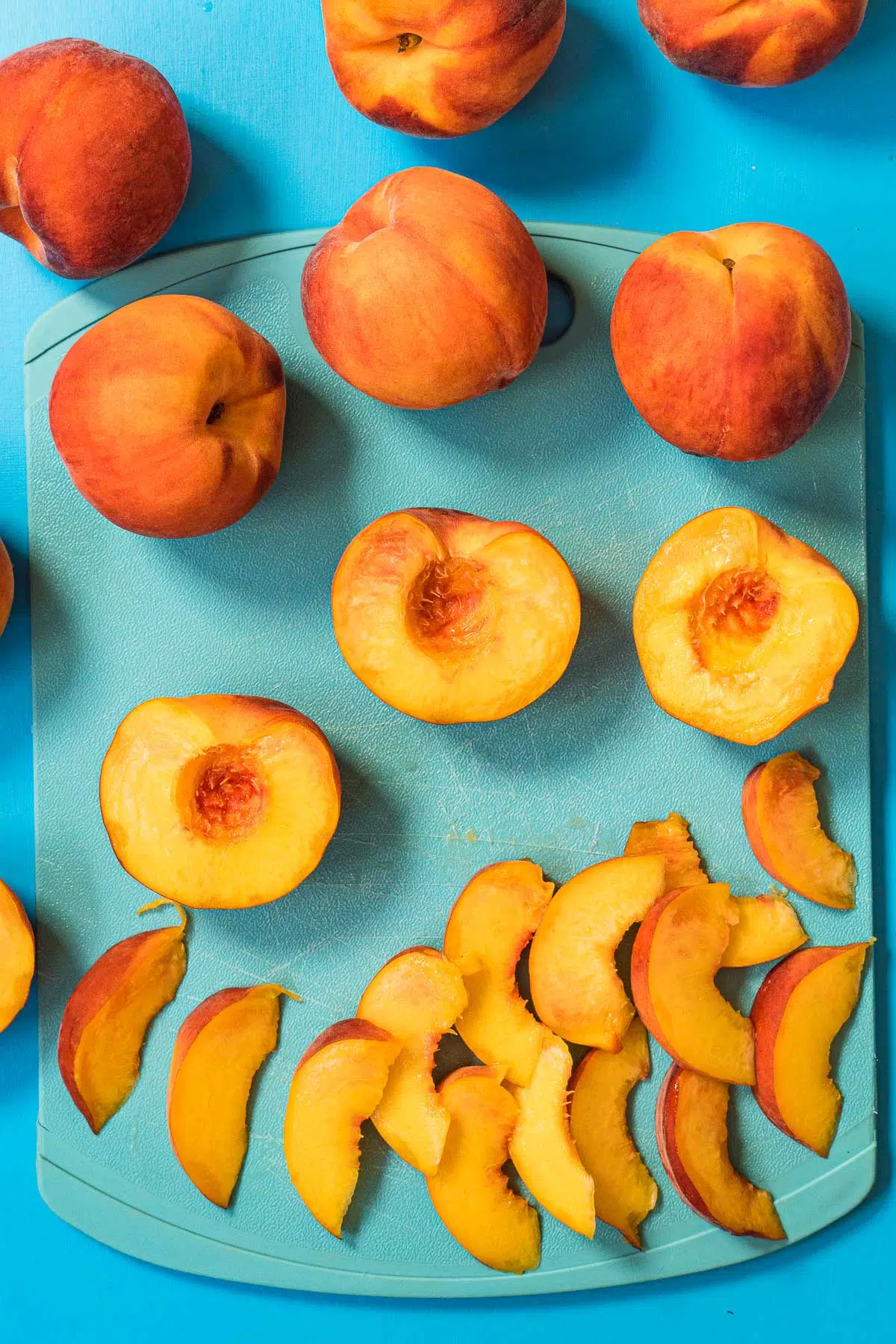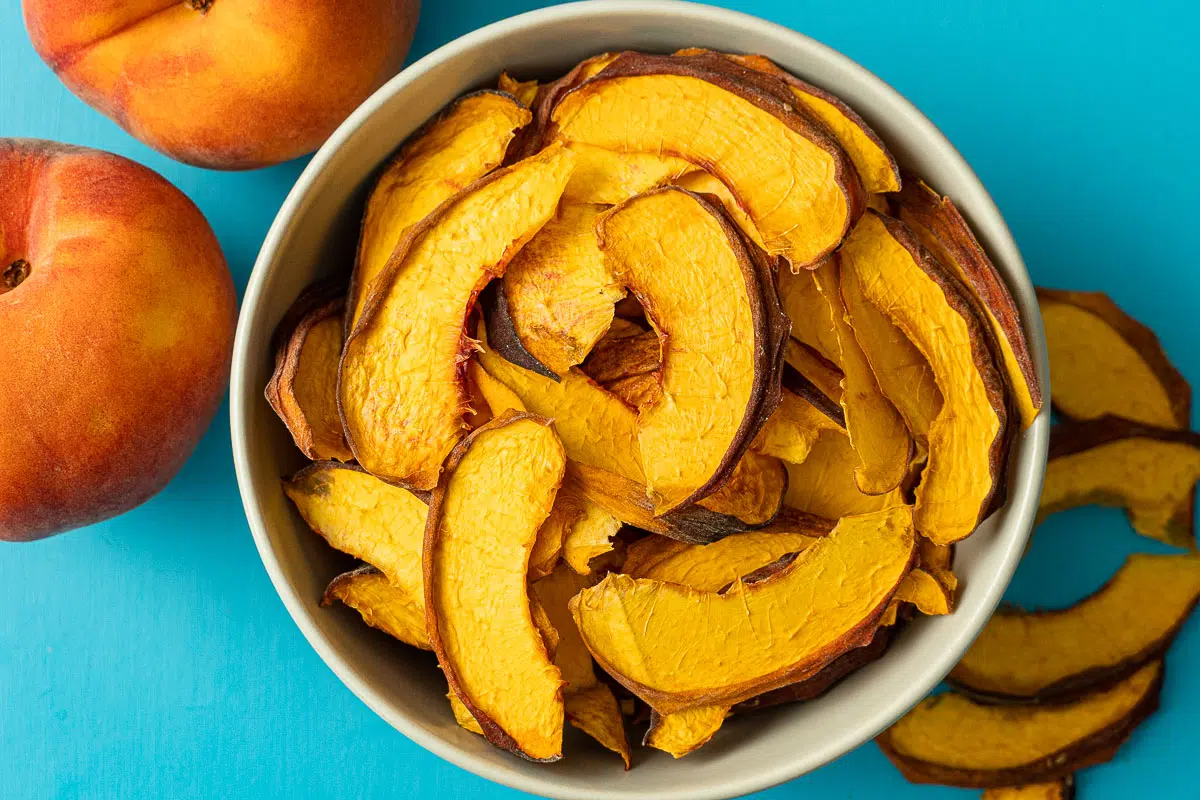How to Dehydrate Peaches
This post may contain affiliate links.
Capture the fleeting flavor of summer by dehydrating peaches! Dehydrated peaches are great for storing seasonally harvested peaches for long-term storage or for easy snacking.

Thanks to global shipping, they are very few foods that can truly only be found when in season. From Mexican strawberries to Chilean apples, North American supermarkets are brimming with “seasonal” produce all year long.
But one of the biggest exceptions are peaches! Look high and low, but you can not find a peach anywhere in January. They’re a summer fruit and summer is the only time you can get them.
In addition to canning and making jams, one of the best ways to capture this summertime bounty is to dehydrate peaches. Dehydrated peaches retain nearly all of their flavor and can be eaten as chips for a snack or rehydrated to make a peach cobbler.
So if you want to extend your own personal peach season, grab a bushel and a dehydrator, and let’s make some dehydrated peaches!

Choosing Peaches To Dehydrate
There is a real art to picking a good peach. Thankfully there are lots of subtle clues to look to help you find the best ones.
Color: For yellow peaches and nectarines, the key indictor to look for is dark yellow or golden skin color. The red color has actually bean bred into peaches by farmers to make them look more appetizing and don’t tell you much about the peaches ripeness. Dark yellow is the color you’re looking for, particularly around the stem. Pale yellow or even hues of green indicate the peach was picked too soon.
For White peaches, you do want to see a pale yellow undertones in the “white” around the stem. Snowy white or white with hues of green, indicate the peach was harvested too soon.
Appearance: Obviously avoid any peaches with bruises, blemishes, or dark spots. But things you do want to look for is roundness and wrinkly skin. Peaches will becomes slightly rounder as they ripen, so avoid any that have a sharp angle crease. Wrinkly skin around the stem indicates water evaporation through the skin and means the peach is ripe.
Scent: Smell the top of the peach, by the stem. A ripe or nearly-ripe peach will have a rich, floral fragrance – almost like you are tasting it just by smelling. Conversely, an under ripped peach will smell muted and flat.
Softness: Softness should be gauged with caution. Peaches bruise VERY easily, so firmly squeezing a peach will ruin it. However, if you pick up a peach in your hand and just gently wrap your fingers around it, you will be able to tell if the flesh has any give. A peach that is rock hard is unripe, but if it has a slight give to it, you’re on the right path.
Any really soft or mushy spots on a peach are likely bruises, possibly from some over zealous fruit squeeze. Avoid.
Choose organic peaches if possible, as peaches are on the “dirty dozen” list, meaning they are more likely to contain pesticide residues.

Prepping Peaches For Dehydrating
First, make sure your peaches are completely ripe. You want all the sugars to have fully developed, so the dehydrated peaches will taste rich and sweet. If you need to speed up the ripening process, you can place your peaches in a brown paper bag over night.
Before you start prepping your peaches, make sure your counters, equipment, and hands are clean & sanitized to prevent contamination, which can spoil your batch down the line.
- Remove the skin (optional!): Peach skin is thin and totally edible, so if you want you can leave it on—just make sure you wash them thoroughly. If you’d rather remove the skin, the fastest way is to blanch the peaches in boiling water for 30 seconds, then remove and place them in an ice bath. Once cooled, you should be able to easily peel off the skin with your fingers.
- Slice the peaches & remove the pit: Using a sharp knife, cut the peach in half and remove the pit.
- Cut into Slices: For a chewy peach chip consistency, aim for about 1/2” inch thick. For a more brittle, crunchy peach chip consistency, aim for about 1/4” inch thick.

How To Dehydrate Peaches
Dehydrating peaches is super easy! Once your peaches are prepped, set up your dehydrator and follow these steps:
- Arrange the peach slices on your dehydrator trays. Make sure to leave some space between the pieces to allow air to circulate.
- Dehydrate at 135ºF (52ºC) for 8-12 hours until the peaches are dry and leathery (they will still be a bit pliable).
- Depending on your machine, you may need to rotate the trays periodically to promote even drying.
Equipment Spotlight: Dehydrators
If you’re in the market for a dehydrator, we recommend buying one with an adjustable temperature. This will allow you to dial in the drying temp to give you the best results for individual ingredients. The dehydrator we recommend (and use) most often is the COSORI Premium. You can also check out our best dehydrators post for a comparison of all the dehydrators we’ve used and would recommend.
How To Tell When Peaches Are Done
It’s important to note that the drying time given is just an estimate—there are a lot of factors that may contribute to longer or shorter drying times (humidity, home temperature, dehydrator load, etc). The way to tell if your peaches are dry is to physically check them.
Peach slices should be leathery in texture when properly dried. To test, remove a slice and let it completely cool. They will have some bend but if you tear one in half and squeeze it, there should be no moisture that seeps out. If they have any signs of remaining moisture, put them back into the dehydrator dry longer.

How To Store Dried Peaches
If you’re drying peaches for snacking and plan on eating them within a week or so, you can store them in a sealed container or zip-top bag on the counter or in your pantry. Just let them cool and place them in a sealed container. We like to use these reusable ReZip bags.
However, if properly dried and stored, dehydrated peaches can last up to a year! Here are our tips for long term storage:
- Cool: Let the peaches cool completely before transferring them.
- Condition: Loosely pack the peaches in a transparent airtight container. Check it daily for a week to check for signs of moisture or condensation, and shake to help prevent the peaches from sticking together. If signs of moisture appear, stick them back into the dehydrator (as long as there’s no mold—in that case, toss the batch). After a week, if there’s no signs of moisture or mold, you can package them for long-term storage.
- Store in a clean, airtight container. For longer shelf life, vacuum seal.
- Use a moisture absorbing desiccant packet if you anticipate opening the container often, or if you live in an area with high humidity.
- Label the container with the date and any other important details
- Place the container in a cool, dark, and dry place—inside of a pantry cabinet works well.
Vacuum sealing tips
We like to store our dehydrated food in mason jars that have been vacuum-sealed using this handheld

How To Use
Dehydrated peaches are great to have on hand as a healthy snack, but here are a few more ideas on how to use them:
- Add to trail mix
- Top oatmeal or yogurt with chopped, rehydrated pieces
- Add to granola
- Add to iced tea while it’s brewing
- Chop and rehydrate before adding them to scone or muffin batter
- Rehydrate and simmer with some sugar to create a jammy compote for pancakes, waffles, oatmeal, or ice cream
- Turn them into powder to add to yogurt, cake or cupcake batter, ice cream, smoothies, cream cheese, and more!
- Include as part of a cheese plate or charcuterie board


Equipment
- Airtight storage container
- Vacuum sealer (optional)
Ingredients
- Ripe peaches
Instructions
- Start with clean hands, equipment, and countertops.
- Wash the peaches and peel if desired. Remove the pit by slicing each peach in half and pulling out the seed (a spoon can be helpful in easing out stubborn pits).
- Slice the peaches into ¼"-½" thick slices using a sharp knife. The thinner they are, the crispier they will become in the dehydrator.
- Arrange peach slices in a single layer on dehydrator trays, ensuring there is space between pieces to allow airflow.
- Dehydrate at 135F/57C for 6-12 hours, until dry (see note).
Storage Tips
- Let the dried peaches cool completely before storing.
- Short term storage: If the peaches will be consumed within a week or two, store in a ziptop bag or sealed container on the counter or in a pantry.Long-term storage: Condition by loosely packing the dried peaches in a transparent, airtight container. Leave it on the counter for a week and check it daily for signs of moisture. If condensation appears, return the peaches to the dehydrator (unless there are signs of mold—then, throw out the whole batch). Shake occasionally to keep the peaches from sticking together.
- After conditioning, store in an airtight container in a cool, dark place for up to a year. Vacuum sealing will help extend the shelf life and quality of the peaches.
Notes
Peach slices should be leathery and pliable in texture when properly dried. To test, remove a slice and let it completely cool. They may have some bend but if you tear one in half and squeeze it, there should be no moisture that seeps out. If they have any signs of remaining moisture, put them back into the dehydrator to dry longer.
